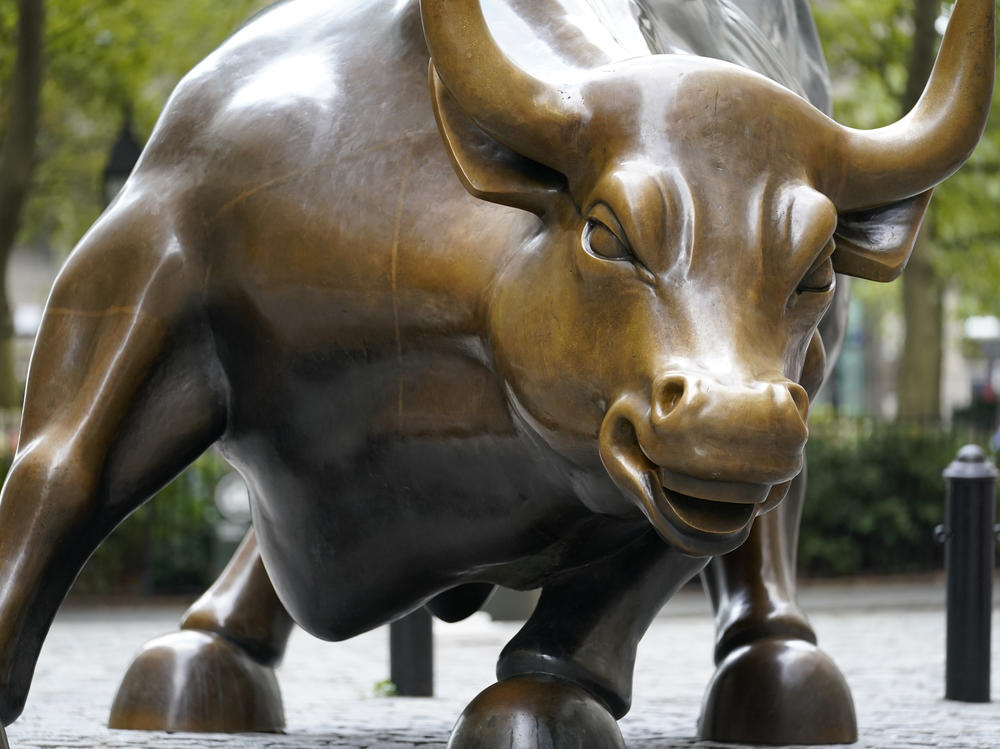Loading...
Section Branding
Header Content
Dow Surges Past 30,000 Points For 1st Time In Historic Milestone
Primary Content
Updated at 4:20 p.m. ET
Not even the pandemic could keep the Dow from breaking a major milestone: the 30,000-point barrier.
The Dow Jones Industrial Average powered past 30,000 for the first time Tuesday after President Trump allowed the transition process to begin, even as he has yet to concede.
Investors had been growing worried that Trump's refusal to allow proceedings to begin would hamper President-elect Joe Biden as he prepares to take office.
The Dow ended up 1.5% at 30,046 points. The S&P 500 ended up 1.6%, while the Nasdaq composite index rose 1.3%.
Trump, who has frequently touted the market during his tenure, addressed the record for the Dow in short remarks Tuesday at the White House.
"It's a sacred number, 30,000," Trump said. "Nobody thought they'll ever see it."
Markets were also boosted by news that Biden was set to nominate former Federal Reserve Chair Janet Yellen as his Treasury secretary, putting in place an experienced person at the helm of the government's economic levers, should she be confirmed.
Shares were already headed for big gains this month as progress on developing COVID-19 vaccines by several companies is raising hopes for a return to normalcy for the global economy, even as a spike in coronavirus cases reinforces concerns about the short-term outlook.
The record for the Dow caps a remarkable comeback from an index that in mid-March reached a low of 18,214, at the height of market fears about the pandemic. Before the pandemic, the Dow had flirted with 30,000, reaching a closing high of 29,569 in February.
Shares gradually began to recover in April, in part because of quick action by the Federal Reserve and Congress, which set up lending programs for businesses and local governments, while also providing critical support to markets.
While these programs weren't heavily used, their availability was enough to convince investors it was safe to return to the markets.
The quick action by the Fed and Congress stands in stark contrast to the way the government handled the 2008 global financial crisis when government officials had no playbook to revitalize the economy, says Michael Arone, chief investment strategist at State Street Global Advisors.
"This time around there was a playbook, and we put that playbook on steroids, and it was followed quickly and aggressively. And so I think that was a big difference-maker this time around," Arone says.
The market started taking off in earnest by the summer as investors piled into big tech companies such as Apple and Microsoft, which have fared well during the lockdowns.
Stocks have now been given a boost by the prospect of vaccines, even as new lockdowns imposed around the world reignite concerns about the toll on the global economy.
"Despite the challenges – and there are considerable challenges – I think there's optimism that the foundation for markets is strong and that the economy continues to recover," Arone says.
Still, analysts also urged caution given the lingering uncertainties about how soon a vaccine can be rolled out and the prospect that the global economy could take a long time to climb out of its deep hole.
Just over half of the 22 million jobs lost in the United States during the pandemic have come back, and relief provided by Congress, including extra unemployment checks, are due to expire by the end of the year.
The expiration comes as Congress remains far apart on a new deal. The Senate is also seen as likely to remain in Republican hands after runoff elections on Jan. 5 in Georgia. That would make it harder for the Biden administration to clinch a new agreement should lawmakers fail to achieve a deal by the end of the year.
"Since it will be some time before a vaccine is widely available, social mobility and economic activity will be somewhat restricted in the months immediately ahead," says David Joy, chief market strategist at Ameriprise Financial.
But the stock market tends to look past immediate concerns to bet on the future, he says.
"From today's perspective, that future looks a lot closer to normal for the economy," Joy says.
Milestones in the Dow have no technical significance. The psychological impact can be strong, however. The Dow is one of the world's best-known stock indexes by far, and hitting 30,000 sends a message that can boost public confidence in the market's strength.
The Dow hit 20,000 for the first time in January 2017.
Copyright 2020 NPR. To see more, visit https://www.npr.org.

